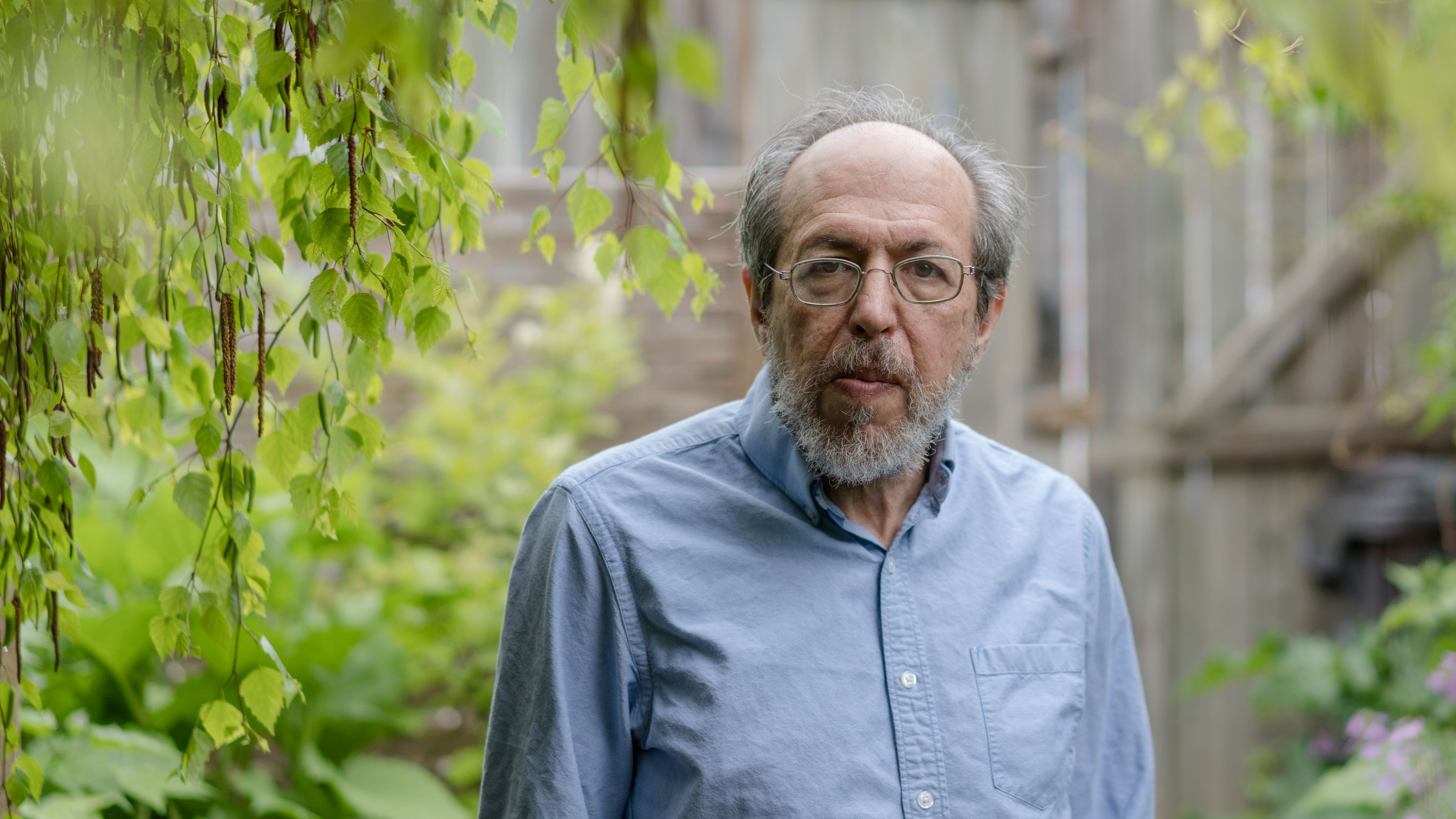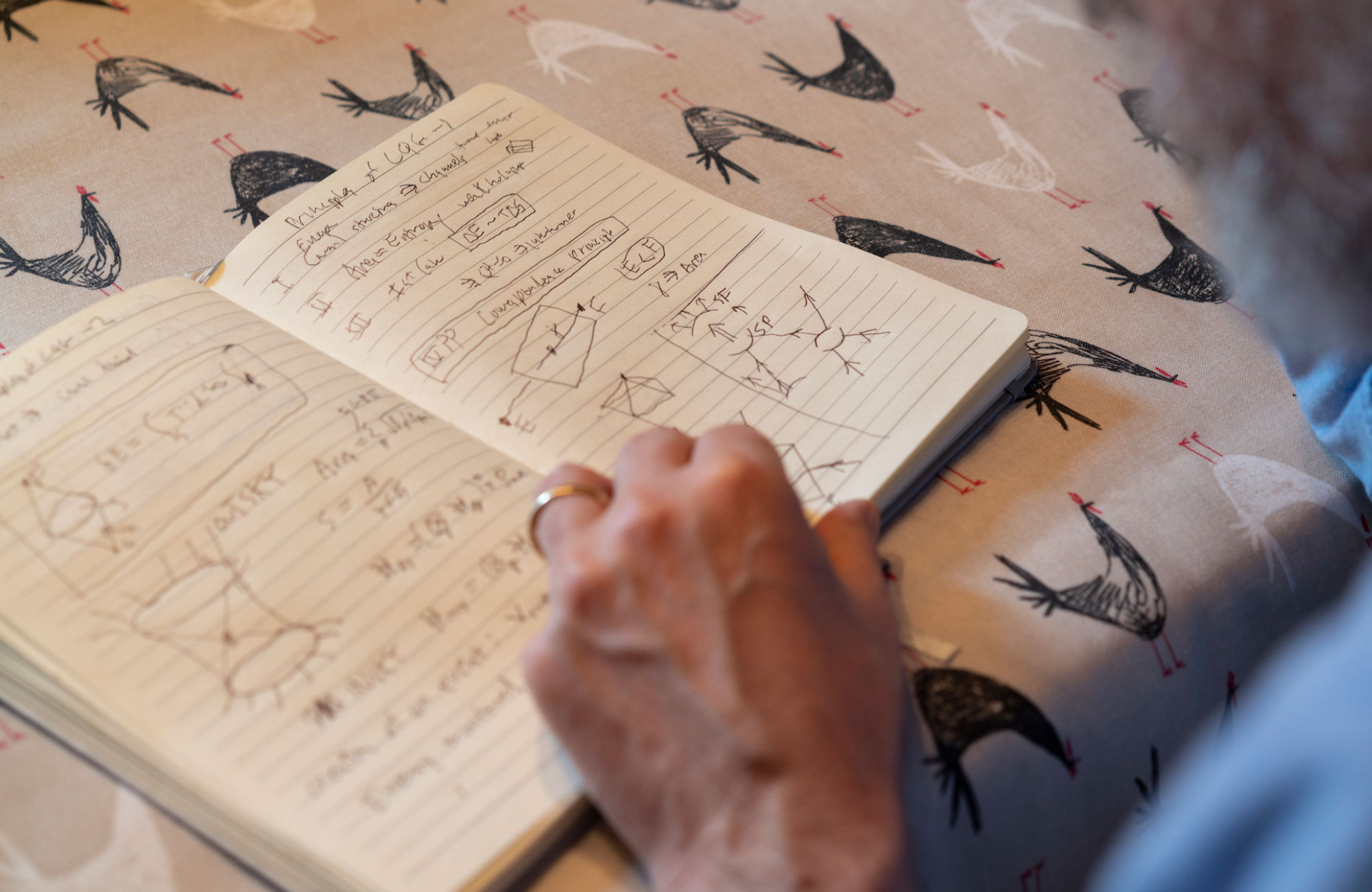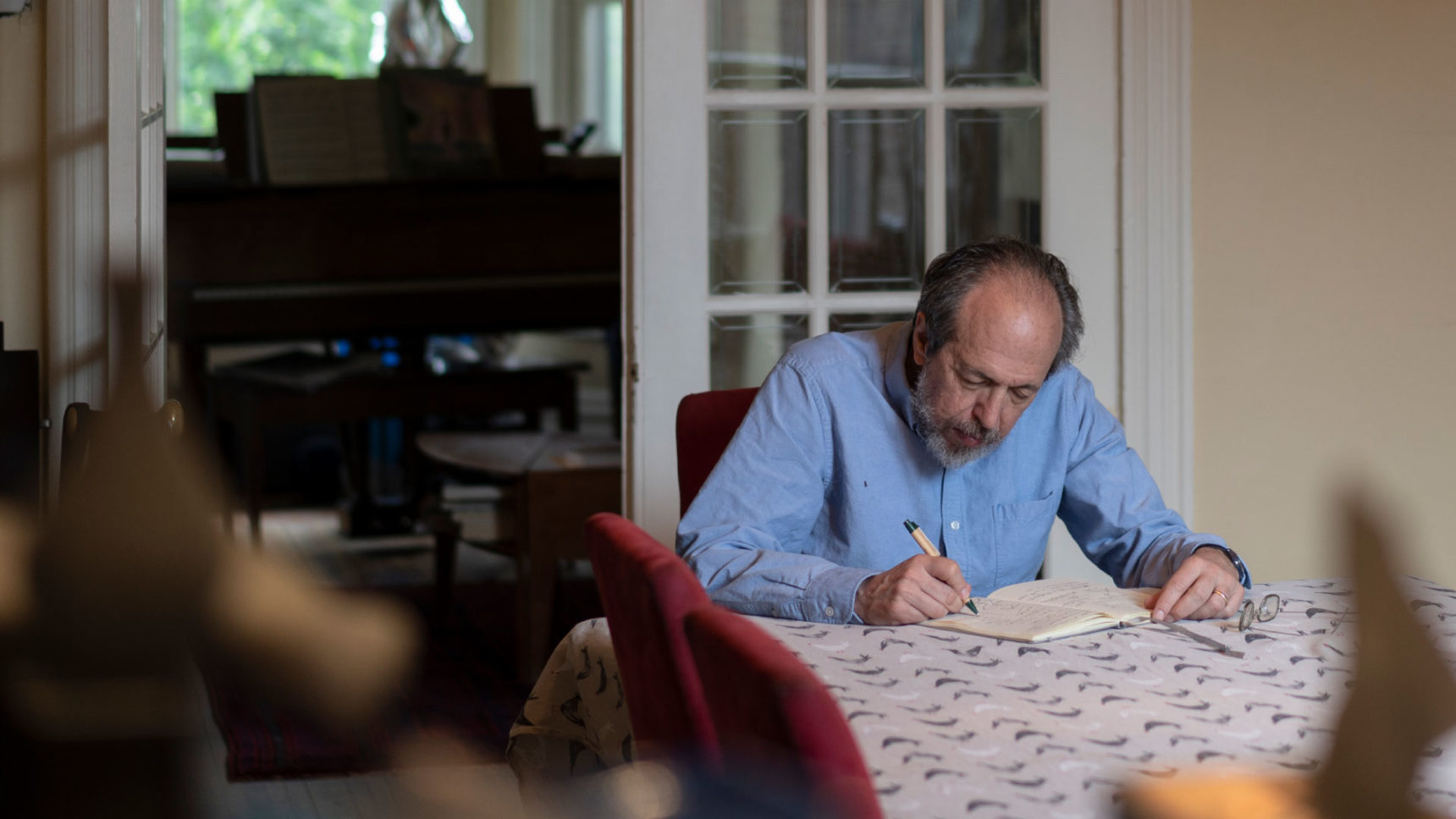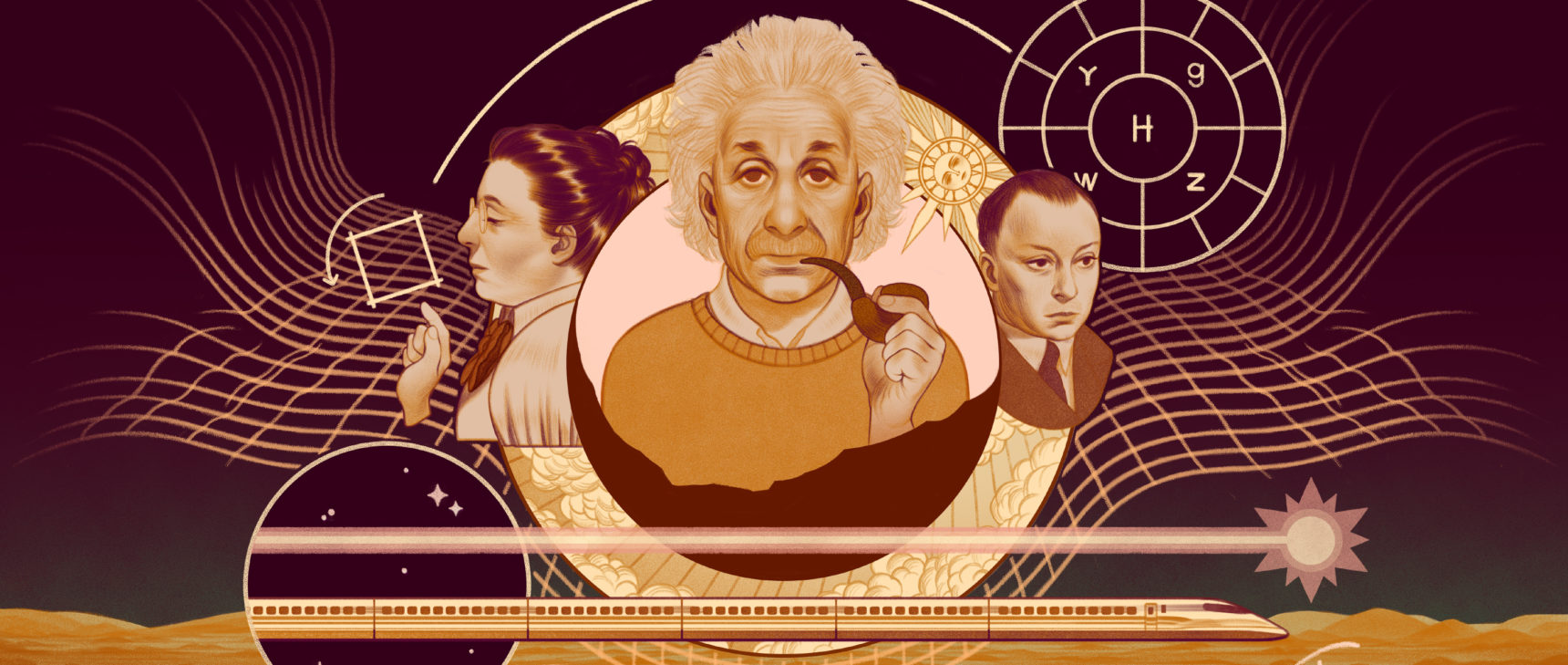How to Understand the Universe When You’re Stuck Inside of It

Lee Smolin at his home in downtown Toronto.
Philip Cheung for Quanta Magazine
Introduction
The universe is kind of an impossible object. It has an inside but no outside; it’s a one-sided coin. This Möbius architecture presents a unique challenge for cosmologists, who find themselves in the awkward position of being stuck inside the very system they’re trying to comprehend.
It’s a situation that Lee Smolin has been thinking about for most of his career. A physicist at the Perimeter Institute for Theoretical Physics in Waterloo, Canada, Smolin works at the knotty intersection of quantum mechanics, relativity and cosmology. Don’t let his soft voice and quiet demeanor fool you — he’s known as a rebellious thinker and has always followed his own path. In the 1960s Smolin dropped out of high school, played in a rock band called Ideoplastos, and published an underground newspaper. Wanting to build geodesic domes like R. Buckminster Fuller, Smolin taught himself advanced mathematics — the same kind of math, it turned out, that you need to play with Einstein’s equations of general relativity. The moment he realized this was the moment he became a physicist. He studied at Harvard University and took a position at the Institute for Advanced Study in Princeton, New Jersey, eventually becoming a founding faculty member at the Perimeter Institute.
“Perimeter,” in fact, is the perfect word to describe Smolin’s place near the boundary of mainstream physics. When most physicists dived headfirst into string theory, Smolin played a key role in working out the competing theory of loop quantum gravity. When most physicists said that the laws of physics are immutable, he said they evolve according to a kind of cosmic Darwinism. When most physicists said that time is an illusion, Smolin insisted that it’s real.
Smolin often finds himself inspired by conversations with biologists, economists, sculptors, playwrights, musicians and political theorists. But he finds his biggest inspiration, perhaps, in philosophy — particularly in the work of the German philosopher Gottfried Leibniz, active in the 17th and 18th centuries, who along with Isaac Newton invented calculus. Leibniz argued (against Newton) that there’s no fixed backdrop to the universe, no “stuff” of space; space is just a handy way of describing relationships. This relational framework captured Smolin’s imagination, as did Leibniz’s enigmatic text The Monadology, in which Leibniz suggests that the world’s fundamental ingredient is the “monad,” a kind of atom of reality, with each monad representing a unique view of the whole universe. It’s a concept that informs Smolin’s latest work as he attempts to build reality out of viewpoints, each one a partial perspective on a dynamically evolving universe. A universe as seen from the inside.
Quanta Magazine spoke with Smolin about his approach to cosmology and quantum mechanics, which he details in his recent book, Einstein’s Unfinished Revolution. The interview has been condensed and edited for clarity.

Philip Cheung for Quanta Magazine
You have a slogan: “The first principle of cosmology must be: There is nothing outside the universe.”
In different formulations of the laws of physics, like Newtonian mechanics or quantum mechanics, there is background structure — structure which has to be specified and is fixed. It’s not subject to evolution, it’s not influenced by anything that happens. It’s structure outside the system being modeled. It’s the framework on which we hang observables — the observer, a clock and so forth. The statement that there’s nothing outside the universe — there’s no observer outside the universe — implies that we need a formulation of physics without background structure. All the theories of physics we have, in one way or another, apply only to subsystems of the universe. They don’t apply to the universe as a whole, because they require this background structure.
If we want to make a cosmological theory, to understand nature on the cosmological scale, we have to avoid what the philosopher Roberto Unger and I called “the cosmological fallacy,” the mistaken belief that we can take theories that apply to subsystems and scale them up to the universe as a whole. We need a formulation of dynamics that doesn’t refer to an observer or measuring instrument or anything outside the system. That means we need a different kind of theory.
You’ve recently proposed such a theory — one in which, as you put it, “the history of the universe is constituted of different views of itself.” What does that mean?
It’s a theory about processes, about the sequences and causal relations among things that happen, not the inherent properties of things that are. The fundamental ingredient is what we call an “event.” Events are things that happen at a single place and time; at each event there’s some momentum, energy, charge or other various physical quantity that’s measurable. The event has relations with the rest of the universe, and that set of relations constitutes its “view” of the universe. Rather than describing an isolated system in terms of things that are measured from the outside, we’re taking the universe as constituted of relations among events. The idea is to try to reformulate physics in terms of these views from the inside, what it looks like from inside the universe.
How do you do that?
There are many views, and each one has only partial information about the rest of the universe. We propose as a principle of dynamics that each view should be unique. That idea comes from Leibniz’s principle of the identity of indiscernibles. Two events whose views are exactly mappable onto each other are the same event, by definition. So each view is unique, and you can measure how distinct one is from another by defining a quantity called the “variety.” If you think of a node on a graph, you can go one step out, two steps out, three steps out. Each step gives you a neighborhood — the one-step neighborhood, the two-step neighborhood, the three-step neighborhood. So for any two events you can ask: How many steps do you have to go out until their views diverge? In what neighborhood are they different? The fewer steps you have to go, the more distinguishable the views are from one another. The idea in this theory is that the laws of physics — the dynamics of the system — work to maximize variety. That principle — that nature wants to maximize variety — actually leads, within the framework I’ve been describing, to the Schrödinger equation, and hence to a recovery, in an appropriate limit, of quantum mechanics.
I know from your book that you’re a realist at heart — you believe strongly in a reality independent of our knowledge of it — and therefore, like Einstein, you think quantum mechanics is incomplete. Does this theory of views help complete what you think is missing in quantum theory?
Einstein — as well as someone called Leslie Ballentine — advocated an “ensemble interpretation” of the wave function [the mathematical object that represents a quantum system]. The idea was that the wave function describes an ensemble of possible states. But one day, I was sitting in a cafe working and suddenly I thought: What if the ensemble is real? What if, when you have a wave function describing a single water molecule, it’s actually describing the ensemble of every water molecule in the universe?
So whereas normally we would think that there’s one water molecule but an uncertainty of states, you’re saying that the uncertainty of states is actually the ensemble of all the water molecules in the universe?
Yes. They form an ensemble because they have very similar views. They all interact with one another, because the probability of interaction is determined by the similarity of views, not necessarily their proximity in space.
Things don’t have to be near each other to interact?
In this theory, the similarity of views is more fundamental than space. Often, two events have similar views because they’re close in space. If two people stand next to each other, they have very similar, overlapping views of the universe. But two atoms have many fewer relational properties than big, complex objects like people. So two atoms far apart in space can still have very similar views. That means that at the smallest scale, there should be highly nonlocal interactions, which is exactly what you get with entanglement in quantum mechanics. That’s where quantum mechanics comes from, according to the real-ensemble formulation.
It reminds me of a lot of work that’s going on now in physics that’s finding surprising connections between entanglement and the geometry of space-time.
I think a lot of that work is really interesting. The hypothesis that’s motivating it is that entanglement is fundamental in quantum mechanics, and the geometry of space or space-time emerges from structures of entanglement. It’s a very positive development.
You’ve said that these ideas were inspired by Leibniz’s Monadology. Did you just happen to pull out your Monadology and reread it?
I first read Leibniz at the instigation of Julian Barbour, when I was just out of graduate school. First I read the correspondence between Leibniz and Samuel Clarke, who was a follower of Newton, in which Leibniz criticized Newton’s notion of absolute space and absolute time and argued that observables in physics should be relational. They should describe the relations of one system with another, resulting from their interaction. Later I read the Monadology. I read it as a sketch for how to make a background-independent theory of physics. I do look at my copy from time to time. There is a beautiful quote in there, where Leibniz says, “Just as the same city viewed from different directions appears entirely different … there are, as it were, just as many different universes, which are, nevertheless, only perspectives on a single one, corresponding to the different points of view of each monad.” That, to me, evokes why these ideas are very suitable, not just in physics but for a whole range of things from social policy and postmodernism to art to what it feels like to be an individual in a diverse society. But that’s another discussion!

Smolin works out a simple calculation in his “causal theory of views.” The theory describes the information each event has about events in its immediate past, which is called the “view” of the event. The universe grows by the continual creation of new events following a law that maximizes the diversity of all these partial views of it.
Philip Cheung for Quanta Magazine
Your work has been very influenced by philosophy. Looking back historically, people like Einstein and Bohr and John Wheeler all took philosophy very seriously; it directly influenced their physics. It seems to be a trait of great physicists and yet —
And also of not-great physicists.
OK, fair! It just seems that it’s become almost taboo to talk about philosophy in physics today. Has that been your experience?
Not at all. Many of the leading theorists in foundational physics — where the goal is to deepen our knowledge of the fundamental laws — know philosophy very well. As an undergraduate at Hampshire College, I did a lot of physics and some philosophy courses. Then when I went to Harvard for graduate school, I intended to do a double Ph.D. in physics and philosophy, but I got disenchanted with philosophy pretty quickly. I mean, the physicists were arrogant enough. But the philosophers even more so.
Back when we had the revolutions in physics in the first part of the 20th century in Europe, people like Einstein, Bohr, Heisenberg, Schrödinger and others were very well educated in philosophy, and it informed their work as physicists. Then there was this pragmatic turn, where the dominant mode of physics became anti-foundational, anti-philosophy.
The historian of physics David Kaiser at MIT has studied this in detail. He studied quantum mechanics textbooks and lecture notes and saw how, through the 1940s into the 1950s, references to philosophy and to foundational issues disappeared from quantum mechanics courses. Freeman Dyson once said, normally the young people are rebels and the old people are the conservatives, but in his generation it was the reverse. The young people didn’t want to hear about messy philosophy or foundational issues, they just wanted to get out and apply quantum mechanics.
This was great for the explosion of applications of quantum mechanics from the 1940s into the 1970s, through the establishment of the Standard Model, condensed matter physics and so forth. But then fundamental physics got stuck, and part of the reason we got stuck is we reached a set of problems on which you can’t make progress with this pragmatic, anti-foundational culture. I should make clear that those fields where you can assume we know the relevant laws, like condensed matter and astrophysics, continue to thrive. But if your goal is to discover new, deeper laws, you need to mix with philosophers again. And it has been happening much more.
When I started mixing with philosophers, there were a few who really knew physics well, but most didn’t. Today, the young people working in philosophy of physics, for the most part, know physics well. The interchange with philosophy is coming back, and I think it’s a good thing.




